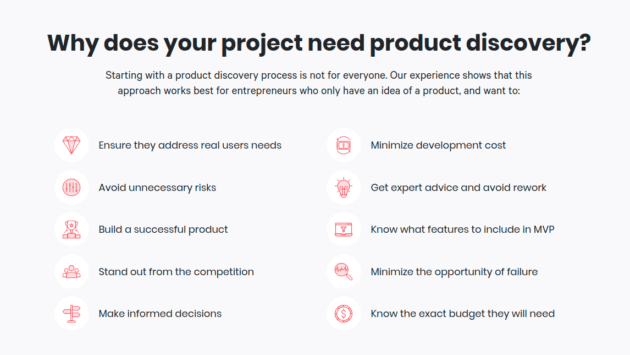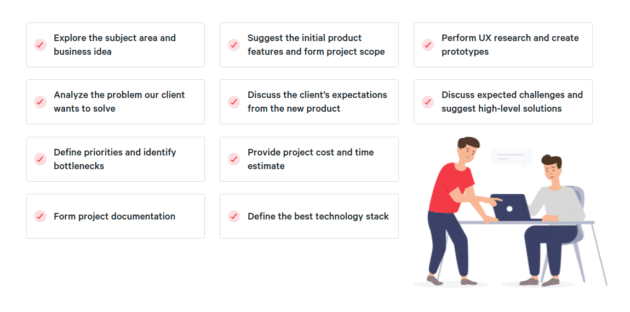So, you have a brilliant startup idea, what’s next? As they say, a well-started product is a half-built product. The best practices show that a good start of work on a web project almost every time involves a product discovery phase.
According to a recent McKinsey report, about 17% of all IT projects do not succeed. Only 7% are delivered with a delay, and about 50% exceed the budget. What can prevent these and other possible startup failures? The best practices show that timely, careful analysis and planning can help prevent some pitfalls. As a way out, the discovery phase is a must-have for businesses that wish to know how to complete their new project on time and within a comfortable budget.
So, let’s find out what happens during the discovery phase, why it is essential, and what benefits it brings to the business owners.
Why does your product need a discovery phase?
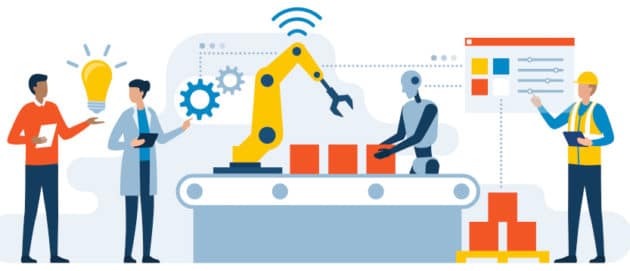
The product discovery debut started at the beginning of the 2000s. It was a consistent reaction to the running method of the product development process that might take years in some cases.
In 2001, the release of Agile Manifesto offered a more time-effective alternative to slow, inaccurate product development. The agile approach became a real game-changer since it encouraged software development teams to go small and fast. Eventually, this new practice trained teams to build products that customers could use and, thus, will love.
At the same time, design thinking and UX design became a new black, changing the main focus of product development on clients rather than business owners. The UX prompted product development teams to ask a new bold question: What do the clients actually need?
And this client-centric approach forms the heart of the then-new product discovery process.
Recommended for you: Advantages and Disadvantages of Using WordPress for Your Next PHP Project.
Product Discovery basics
Product discovery is what it sounds like. No hidden meaning. Just a very intensive and accurate research phase or consultation before any development. Depending on the scope and the complexity of the work, this phase can take from one week to several months. The cost of product discovery depends on the project complexity but usually makes from 5% to 10% of total development costs.
General recommendation: this phase is crucial for businesses with just an idea to validate before moving any further and building an MVP or a complex product. Even though discovery is the desired phase for a good start, not all startups and products need this initial stage. We’ll talk about it later.
So far, find the key reasons why you, as a business owner, should consider discovery sessions for your new product.
However, there are some situations when you can omit the discovery stage with little risk:
- If you already have all project documentation from, let’s say, another software vendor.
- If you just need to make some minor changes to the existing, ongoing project.
As you can see, there are exceptions to the main product development rule of discovery as a must. Now let’s find out what’s happening during a product discovery phase and who is usually involved.
What happens during a product discovery phase?
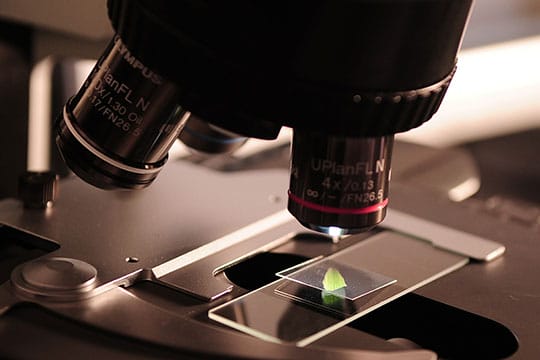
Discovery promise: Every new product can avoid risks and possible rework right from the start. If you want to know the development team and receive an estimate, give discovery a try.
What’s behind this pre-development phase, and how to proceed.
1. Explore the subject area of the project

To begin with, a client shares in detail the idea behind the product, how it should perform, what features are considered a must-have, and so on. A filled-out brief questionnaire with product ideas and other related questions will be of great help. The more information is collected at this stage, the better. Once the development team has all the information about the client’s vision, they perform the research and analysis.
2. Define possible bottlenecks

On analyzing, the development vendor comes up with advice on how to nail down end-users problems in the most effective way. Following this, the development team discusses the possible project bottlenecks with the client. Among widespread jams are specific product features or implementation of the expected business logic.
3. Discuss best-suited solutions

In this step, the technical experts offer high-level solutions to the defined above pain points.
To put it simply, they explain why this or that architecture solution meets the product requirements in full. At this stage, the client is offered the most advanced technology stack for future product development. This way, the team ensures that the project will be delivered in the most effective way.
4. Suggest initial features and define a project scope

Finishing with analysis, let’s go on further with specifying a project scope and identifying priorities. This step is essential for both sides: the client and the development vendor. The formed project scope allows all parties to see features descriptions or user stories and is necessary for further accurate estimations.
5. Estimate the project cost and time and finalize the project documentation

Based on all received information, the development team can now finalize all needed project documents. As a rule, these documents include a system requirements specification (SRS) and a set of clickable prototypes. The SRS document covers all the required information for further smooth development. At this stage, the development team also offers accurate time and budget estimations.
It is important to hold regular sessions between the development team and stakeholders, to be on the same page about product expectations and possible updates. Several times a week is usually enough. Among possible session, formats are: in a vendor’s office, in a customer’s office, or, as our time dictates, remotely.
You may like: 8 Excellent Amazon Web Services (AWS) You Should Consider to Use in Your Next Web Application Project.
Discovery benefits for business owners
To sum up, look at the table below with all the aims of the product discovery phase.
During the first meeting in the discovery phase, Project Managers usually ask a business owner a list of clarifying questions. Below is a list of the basic queries:
- What’s the business goal of your product?
- Who is the target audience of your product?
- Who is the main competition?
- What is the project timeline?
- What’s the approximate budget for the project?
To achieve the goals of the project discovery phase, both the development team and the client representatives take part in the sessions. Active involvement from the client side is essential to success.
Below are the top product discovery roles from a client’s and a service vendor’s sides:
- A client’s side:
- Business owner;
- Stakeholders.
- Software service provider’s side:
- Business Analyst / Product Manager;
- UX/UI Designer;
- Software Architect.
If you are still in doubt on why you should spend extra time and budget for the discovery stage, below you can find the deliverables you will receive with this pre-development stage.
What can you count on after product discovery?
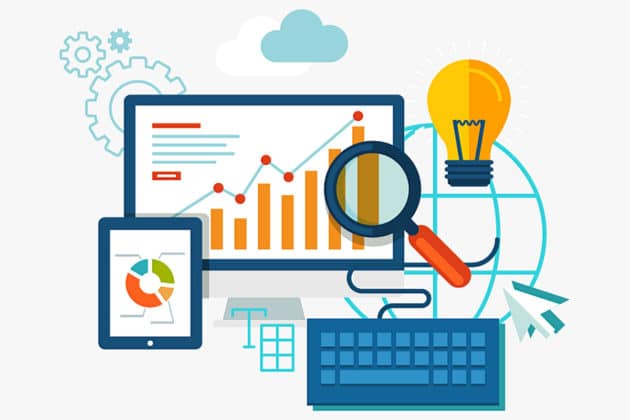
On the very base level, product discovery gives a clue on the business challenges, as well as exact problems that the product’s target audience faces. Starting from here, the development team can find effective solutions to the problem, create all needed documentation and provide estimates.
So, after the discovery phase, you, as a client, can count on the following deliverables:
- Clickable prototypes of the product;
- The list of features with high priority;
- Product details specification;
- Product architecture and tech documentation;
- Accurate costs and time estimation;
- Recommendations for development team formation.
As you can see, the main aim of the discovery phase is to collect detailed project information with both time and cost estimation. In addition, you will end up with the project documentation and clickable prototypes. Now when the spell behind the discovery is broken, let’s see what’s coming next.
After completing the product discovery phase, the next step is product development. It usually includes the following steps: project road map creation, mentioning all functionality and user roles, and finally, building a minimum viable product (MVP).
You may also like: Software Development Project Roles and Responsibilities.
Final thoughts

A project discovery is a crucial development phase for startups with a fresh idea. It allows business owners to validate the concept, get accurate time and cost estimates, and show a vector of future development. In addition, discovery helps receive a detailed technical specification SRS and a precise scope on a timeline.
To be fair, not all businesses need this initial consultancy phase. Minor changes to the product and ready-made project documentation from other service providers are two cases to skip the discovery. Still, it’s always better to start small, try working with the development team, find out the costs and time involved, and of course, reinforce the idea.
The discovery phase aims to save you time and budget and make the development process clearer for all parties when it comes to benefits. When the project’s most significant risks and bottlenecks are revealed in advance, chances are your startup will be a success. One last thing to mention here, discovery is a collaborative effort. Regular communication is the primary key to the effective product discovery phase completion.
